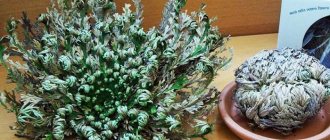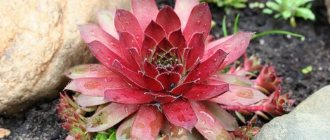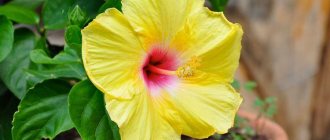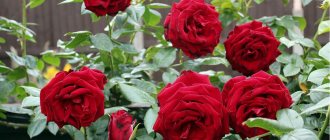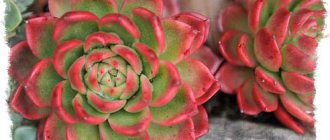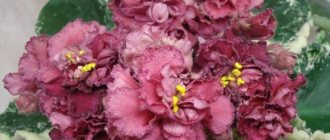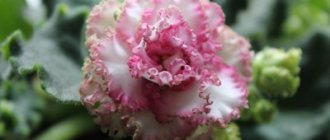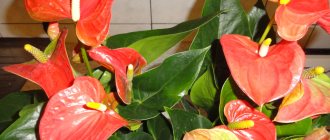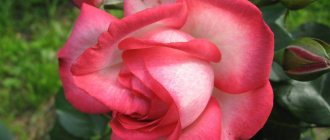A mysterious and amazing flower called the rose of Jericho was first discovered in the Middle Ages. Its peculiarity is that it can remain alive without water for up to a hundred years. When it does not receive moisture for a long time, it curls into a ball and hides the fruits inside. Such balls turn into travelers who search for habitats until the rain overtakes them. When moisture enters, the plant comes to life. After straightening, seeds spill out from the middle of the flower, giving life to new plants.
Legends about the flower
The biblical version of the appearance of this flower claims that Mary discovered the unusual plant on her way to Egypt. She blessed him with immortality. Therefore, it is sometimes called the “hand of Mary.”
The second legend is described in the famous story “The Rose of Jericho” by Ivan Bunin. It says that the name of the herbaceous plant was given by the Monk Savva, who settled in the Judean desert.
Plant in myths, poems and history.
Rose folklore
In Egypt, poems were dedicated to this plant; it was also believed that the flower helps during childbirth. And as an indoor plant that does not require special care, the Rose of Jericho has many fans all over the world.
At one time, the Spanish colonialists used the Rose of Jericho to show the Indians what resurrection was. In general, there are a lot of near-religious legends about this plant. The most beautiful of them says that when the Mother of God went with the baby Jesus Christ and Joseph the Betrothed to Egypt to escape the beating of infants by Herod, she saw this plant and blessed it. After this, it became a symbol of the resurrection of Christ.
To this day, the Rose of Jericho is used in Easter festivities in the Christian Middle East. However, it is possible that this belief originated from the devout crusading knights who first saw the Rose of Jericho on the dusty roads of the Middle East.
And according to popular belief, the rose of Jericho brings a long-awaited baby to the house - that is, it helps against infertility. Whether this is true or not, we don’t know (most likely, speculation), but the fact that it perfectly absorbs smoke, harmful substances and odors is, as they say, a “medical fact.”
Description of the plant
Rose of Jericho (spike moss) is a species of herbaceous annuals of the Brassica family, a member of the genus Anastatica (“the only one”).
This is a small plant, no more than fifteen centimeters long. Small leaves of a grayish tint. The flowers of the plant are very small and white. The Rose of Jericho, the photo of which you see in our article, grows in the desert in early spring, and flowering and fruit set begin very quickly. At this time, there is still enough moisture in the desert for the plant. Like other herbaceous annuals that grow in drought conditions, the rose of Jericho is an ephemeral plant.
With the onset of drought, the tiny stems dry out and begin to curl inward. A kind of ball is formed. Strong gusts of wind easily tear off the top part of the plant, and it rolls along the sand. Along the way, it collects the same tangles and forms very large tumbleweeds. They move around until they get stuck in some wetter place. Due to humidity, the stems swell and begin to straighten, and the seeds spill out of them.
It should be noted that the seeds of this amazing plant remain viable for several years, but when placed in a sufficiently humid environment, they germinate in just a few hours.
You need to know that there is another representative of the flora with similar properties - squamosal selaginella. The Rose of Jericho is a completely different, unrelated plant, although the Hawaiian club moss is very similar in its life cycle and appearance to the anastatic plant.
Rose of Jericho - almost immortal, the same age as dinosaurs
Rose of Jericho is sometimes mistakenly referred to as several different plants, but in reality this name refers to only one flowering plant - Anastatica of Jericho. While, for example, Selaginella squamosal is so called for its ability to recover in growth after drying. And this property is characteristic of many, especially non-flowering plants, which include Selaginella lepidoptera, since it is a clubmoss. But let's talk about it in order...
Rose of Jericho (Anastatica hierochuntica) is a low-growing annual herbaceous plant with a woody stem base. As soon as the leaves of a plant fall off, its branches shrink tightly when dry, resulting in a spherical formation. These balls of dried stems are often torn from the roots by the wind and roll across deserts and steppes for many kilometers. At the same time, ripened seeds are dispersed. That is why anastatics is also called tumbleweed. If you put a rose of Jericho rolled into a ball in a plate or bowl with water, then the moistened branches straighten again.
Of course, there is no question of caring for a dead plant. Nevertheless, the mechanism of opening branches, based on physical laws, may be of some interest to children. True, the plant does not turn green, as catalogs of companies selling plants by mail often report. However, the balls open up in any case as soon as they enter a humid environment. The wetted branches straighten, and the plant seems to come to life, resembling a blooming rose. This process can be repeated as desired.
Selaginella, or Selaginella (Selaginella) is a genus of herbaceous spore plants from the department of lycophytes, which includes over 300 species, most of which grow in the tropics and have a varied form: these are bryophyte and turf selaginella, climbing and climbing... About 25 species of selaginella are bred in as ornamental and indoor plants (Selaginella apoda = Aelaginella apoda, Selaginella Krausa = Selaginella Kraussiana, Selaginella martensii = Selaginella Martensii, Selaginella lepidophylla = Selaginella lepidophylla, etc.), and the species Selaginella moellendorffii, which has one of the shortest genomes among higher plants (about 100 megabases), is used in scientific research as a model organism. These are very ancient plants that have lived on planet Earth for more than 290 million years...
Selaginella squamofolia is a unique plant that has the ability to “resurrect” and comes back to life again after decades of being found in a completely dried state! To do this, simply place a seemingly dead ball of dry foliage in water, which will turn into a bright evergreen in a matter of hours!
Selaginella lepidoptera is native to the Chihuahuan Desert, which lies in the vastness of northern Mexico, New Mexico, and the state of Texas. Here this plant, being in a state of deep “sleep”, is able to wait for years for rains that are rare in those parts. And after rain, its leaves quickly come to life, acquiring a green color, and the plant actively lives and reproduces for some time. But, in the absence of new rains and moisture, after some time, it goes to rest again.
It should be noted that attempts to deprive this plant of a period of drought inevitably lead to its death. And when cultivating it indoors (in a greenhouse), it also makes no sense to plant it in fertile soil, much less feed it with fertilizers.
Selaginella lepidophylla (Selaginella lepidophylla) in cultivation is a small ornamental plant with a maximum height of 10-15 cm and a width of about 30-35 cm. The leaves (shoots) are long and branched, complexly scaly. They creep along the ground from the center of the plant. During periods of drought, the leaf stalks of Selaginella lepidoptera, as they dry out, curl into a ball with a diameter of about 10 cm and then gradually dry out almost completely. Selaginella can remain in this inactive state for several months or more, and its lifespan at home usually extends to several years.
Kinds
There are several types of Rose of Jericho, so it is important to know their differences before deciding what kind of care a particular plant needs.
The most common type is Martens rose. It has erect stems that can reach a length of thirty centimeters, but gradually they become lodging. Its branches are slightly reminiscent of ferns, but the tips of the leaves are silvery-white in color.
Selaginella squamofolia has stems that do not grow more than ten centimeters in length. If the humidity in the room is insufficient, they curl into a ball, but as soon as the plant is watered, it immediately comes to life and scatters its leaves.
The most popular rose varieties for growing at home
Rose Lawinia - description of a popular flower
Since this plant has several varieties with different properties, you need to study each of them before having such a flower at home.
Anastastica Jerichontica
Anastatica Jerichontica is the plant that can be found in the wild. According to legend, it can live indefinitely, but its minimum growing season is 30 years.
A very decorative plant, both dried and during activity.
Anastatika Jerichontica in the house
Asteriscus dwarf
This plant is also sometimes called the Egyptian rose, although it has no relation to this flower. It is a herbaceous, flowering plant that blooms in the spring. Ideal for home growing.
Despite the fact that it is an annual, it has the ability to self-propagate.
Selaginella squamofolia
Selaginella squamosal is distinguished by short stems, not exceeding 10 cm in length. If there is a lack of moisture in the room, it immediately gathers into a ball, but as soon as you water it, it comes to life again.
The leaves of the flower look quite interesting - they are covered with small green scales.
Selaginella squamofolia
Growing
Rose of Jericho needs high humidity (at least 60%), so it does not feel very comfortable in indoor conditions. If you want to place this plant not in a florarium, but in an ordinary container, then you should know that with high humidity, good ventilation must be ensured. Place the pot in a tray with peat, sphagnum or expanded clay, which need to be moistened regularly.
It should be noted that the rose of Jericho is a shade-tolerant plant, so you can create a mini-garden placed in a bottle. It will feel fine even on the north side, and if your windows face south, then the plant should be placed away from the window or slightly shaded with gauze or tracing paper.
Another important argument in favor of placing a plant in a bottle is the need to constantly maintain a certain humidity of the substrate (over-drying it is unacceptable). And in an open container, constantly wet soil will be harmful to the plant and can even kill it.
The composition in the vessel (as in the container) should be watered with settled and soft water. Its temperature should be room temperature. The soil for growing roses should be slightly acidic; do not forget to place good drainage at the bottom of the bottle or aquarium.
For better growth, your green pet should be fed from time to time. This is usually done in spring and summer. Use diluted nutritious fertilizer (in a ratio of 1:3). Using a long wire, you should loosen the ground so that air penetrates better into the soil.
Contraindications and side effects
To date, scientists have not conducted much research on the safety of rose of Jericho, whether taken orally or applied to the skin.
Applying Rose of Jericho directly to the skin has no known risks, but it is best to avoid applying it to open cuts or wounds.
If you have diabetes, low blood pressure, high blood pressure, or other metabolic disorders, be sure to talk to your doctor before taking rose of Jericho to lower your blood sugar and blood pressure.
In addition, Rose of Jericho is a folk remedy for inducing labor, so you should consult your doctor before taking it. There is currently insufficient evidence of its safety.
If you have already taken rose of Jericho to induce labor, tell your doctor. It may affect the medications you take during labor. Unfortunately, there are no studies on its potential drug interactions (10).
If you want to take rose of Jericho, talk to your doctor first, especially if you are pregnant or have a medical condition.
Conclusion:
Use caution when taking rose of Jericho during pregnancy, as there is limited research on its safety and because anecdotal reports say it may induce labor. If you are taking medications or have a medical condition, talk to your doctor first.
Rose of Jericho: care
This is a rather whimsical plant, so certain recommendations must be followed.
Temperature
The optimal temperature can be considered +18 degrees. The flower loves warmth, but the indicated indicators should not be exceeded, that is, the room should not be warmer than +20 °C.
Lighting
Rose of Jericho does not tolerate exposure to direct sunlight; light partial shade is much preferable.
Selaginella squamofolia
Many distributors of flower products pass off this plant as the Rose of Jericho. They are very similar, but they are completely different plants. If you were sold Selaginella as the Rose of Jericho, then you should talk a little about this plant. Let's start with the fact that to grow a flower you need loose soil. A mixture of leaf soil, peat and sand in equal quantities is suitable, which should be constantly loosened. It will be good if you add orchid fertilizer to this mixture.
Pour the prepared soil mixture into a wide but low container with holes for drainage. It will be great if you take clay pots. Before filling it with soil, we lay out a drainage layer of pebbles on the bottom. Planting a flower can be done either by spores or by dividing the bush, but the second method is better and easier. Let’s immediately make a reservation that Selaginella’s root system is very delicate, so we do the planting very carefully.
Planting usually begins in the spring. From the overgrown bush we separate sprouts about 5 cm long, preferably with shoots. We plant 5 sprouts per pot. Water the soil in the pots well and cover the pots with film with holes for ventilation for a week. Selaginella does not like direct sunlight, so pots with seedlings should be placed on the semi-shady side, but not in the shade. You should also carefully monitor the temperature so that the temperature does not drop below +12 degrees.
You need to very carefully monitor the behavior of the leaves; from them you can determine the problem that has arisen with the flower:
- The leaves are limp and soft . This means that you have over-watered and the roots are not getting enough air. You should temporarily stop watering and loosen the soil in the pot well;
- The leaves are pale and too elongated . It follows from this that the plant does not have enough lighting and too hard water is used when watering;
- Leaves die off . Very high ambient temperature and insufficient air humidity;
- Rolling leaves . The flower is affected by strong drafts and may require feeding.
As you can see, Selaginella is also a capricious plant, but with quality care it becomes a beautiful ornamental plant.
Feeding and replanting
The soil should be fed monthly. You can use nitrogenous fertilizers. Once every two years (in spring), the rose of Jericho requires replanting to improve growth.
It must be said that the plant is resistant to various diseases and pests. Its only enemy is dry air, which can provoke the development of spider mites. A regular soap solution will help get rid of it.
The plant is propagated by green cuttings. To do this, in early spring, plant them in a small greenhouse and place it in the shade. The cuttings will take root in two weeks.
Growing a flower in open ground
Rose grandiflora
It is optimal to choose seedlings for planting - they can be purchased both in nurseries and from breeders, and you can prepare them yourself. Depending on the planned planting site, it is necessary to choose the most optimal varieties - low-growing or climbing, classic or tall.
The choice of landing site must meet several requirements:
- sufficient illumination with partial shade is required;
- the place should not be in a draft or heavily ventilated;
- Heritage roses should not be planted in lowlands and areas of stagnant water.
Important! It is necessary to avoid planting new bushes in places where old ones grow. Planting can be done both in spring from mid-April to mid-May, and in autumn, from early September to mid-October, in previously deeply dug soil.
Roses of this variety prefer neutral soils, with a slight deviation towards the acidic or alkaline side.
Planting can be done both in the spring from mid-April to mid-May, and in the fall, from early September to mid-October, in previously deeply dug soil. Roses of this variety prefer neutral soils, with a slight deviation towards the acidic or alkaline side.
Loamy or light clay soils are optimal, but other types of soil can be prepared for planting: add sand, compost or humus to heavy soils, and turf soil and organic fertilizers to sandy ones.
The extraordinary beauty of flowers attracts the eye
Boarding procedure
When planting or transplanting in autumn, all leaves are removed from the seedling and the shoots are shortened to 8 buds; this is not required in spring.
- A mash is prepared from water, clay and manure in a ratio of 10:3:3, to which a growth stimulator is added.
- The planting hole should be about 40 by 40 cm in size, with a depth proportional to the size of the root system - from 30 to 50 cm.
- It is necessary to add garden soil, sand, clay, peat and humus into the hole in a ratio of 2:1:1:1:1, with the addition of superphosphate, bone and dolomite flour, and then fill the hole with the contents with water.
- While the water is absorbed, the roots are dipped in clay mash.
- The seedling is installed in a hole with straightened roots; the border of the rootstock should be at least 7 cm below ground level.
- The roots are covered with soil and compacted to avoid the appearance of voids.
- The planted bush is spilled with water, and then, after it is absorbed, it is hilled to a height of about 10 cm.
Beneficial features
Rose of Jericho humidifies the air in the room and serves as a natural freshener, as it emits the aroma of steppe herbs. The plant has bactericidal properties and disinfects the air. In addition, it absorbs tobacco smoke. If a flower is placed in the bedroom, it will promote better sleep. In dried form, the annual can be used to combat moths in the closet.
Rose of Jericho is a very interesting and spectacular plant. With proper care, it will delight you with its exotic beauty.
About the work of Ivan Alekseevich Bunin
When analyzing “The Rose of Jericho”, it is important to say that in conclusion the author wrote that he fearfully awaits the moment when life will cease forever for him and no water, no moisture can revive him, resurrect him, as this one can revive beautiful and wonderful rose. The writer himself calls this “drying out” oblivion
Analyzing the work, it is important to note that Ivan Bunin used a lot of metaphors and comparisons in his story. In addition, when reading the lines written by such a famous representative of classical literature, one can notice personifications that complement the overall picture of what is being told, thereby creating an even greater impression while reading
The work itself belongs to the category of fiction, and specifically prose. However, since it is based on an Eastern legend, we can say that the work contains elements of folklore. A distinctive feature of this story is its eastern folklore basis. Oriental motifs create a special romance and a certain atmosphere when reading.
Cordana mix in the garden. Features of care
Rose bushes will perfectly decorate a garden plot in border plantings located along the alley paths. The low plant looks great in the foreground of landscape compositions. But neighbors such as rhododendron or hydrangea Cordana are not at all happy with the mix.
The first step is to find a convenient place for the rose bush. If there is a small plot of land on the southwestern or southeastern side of the site, then the territorial issue can be considered resolved. The main work for caring for a flower is as follows:
- Before planting the bush, the soil is watered abundantly and a nutrient solution is added.
- After planting a rose, it is closely monitored for the first time. The soil will require loosening and fertilization.
- As necessary, the flower is sprayed with settled water at a comfortable temperature.
- Before the onset of winter, all buds are cut off. The remaining cuttings are used for further propagation of the plant. The bush is sprinkled with sawdust and protected from the effects of adverse weather factors: covered with burlap or other suitable materials. In too harsh a climate, it is advisable to dig up the rose and, together with a lump of earth, transfer it to a home pot until spring.
It is not for nothing that the miniature rose is in great demand among gardeners and ordinary lovers of beautiful plants. Proper care of Cordana mix, following all the rules, will allow you to tame even such a capricious flower. And it will definitely bring joy for a long time with its beautiful blooms. In a pot, a rose will become an unsurpassed beauty, each time proving that it is not in vain that it is considered a symbol of love and greatness.
Growing problems, diseases and pests
Rose in a pot: care and cultivation at home
Most often, the Egyptian rose becomes infected with fungal diseases. To avoid this kind of problem, you should periodically treat the plant with fungicides. To prevent the flower from rotting, the condition of its inflorescences must be monitored especially carefully. The formation of mold is strictly prohibited.
If you take good and proper care of a flower brought from Egypt, it will practically not hurt.
There are situations when spider mites appear on a dry rose. You can cope with the problem using a solution of laundry soap. These pests appear as a result of being in a room with dry air.
Important! After the life cycle, the plant requires a period of rest, which must be carefully ensured. You can prepare a flower for the dormant period in the fall by stopping watering it and reducing the humidity.
As a result, the rose will take the shape of a ball, which can be stored in a dark place until spring.
Asteriscus dwarf
The exquisite and amazing rose of Jericho is rightfully considered an amazing plant that can exist for a century without water and then be reborn in just one day when moisture is supplied. Despite its name, the flower has absolutely no external resemblance to the usual rose.
In nature, the plant travels across endless sands, attracting the attention of plant growers for many centuries. At the same time, it still remains a mystery how a plant can be lifeless, and then, when interacting with water, so quickly revive and bloom
